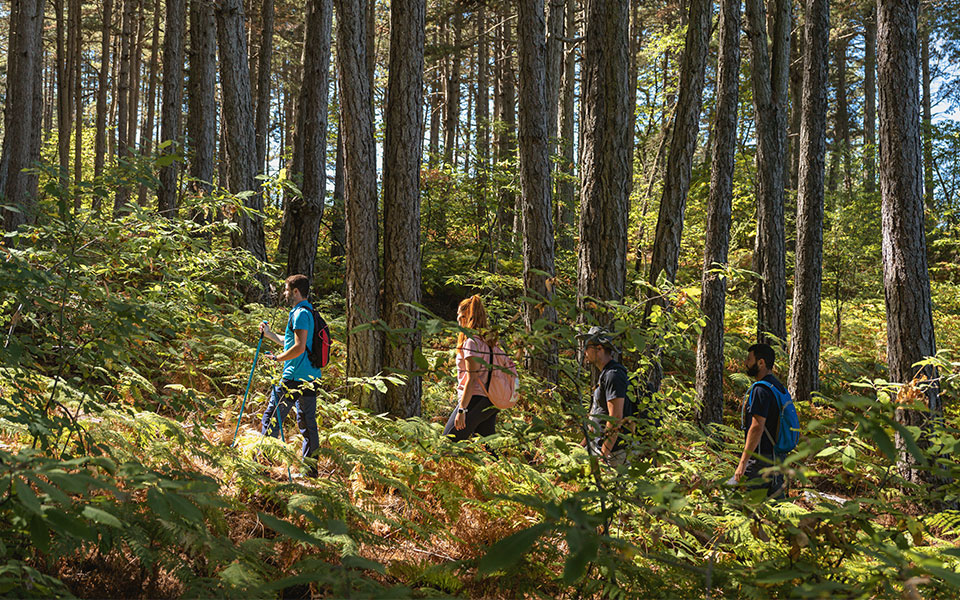We are all watching him tensely jumping into the back of the truck, although he is making it seem so easy, showing us that there is no reason to worry. It is three in the afternoon and another long day of harvesting has just ended on the slopes of the mountain just outside the village of Karyes, on the border between Laconia and Arcadia in the central Peloponnese.
Mr Takis was born in 1936, but his advanced age does not prevent him from coming every day to his estates to pick the nuts from the trees that he inherited from his father and whose number he managed to increase, as he loved nature and agricultural work from a young age. He has planted dozens of chestnut and walnut trees as well as apple and quince trees on the rough and wild mountain near his village. Farming here, at an altitude of 950m, is not an easy task, nor is picking the nuts every October.
In order to collect the walnuts, farmers spread large cloth sheets under the trees, beat the branches with long sticks and then they collect the nuts from the cloths and put them into sacks. Then comes the most difficult part of the work: first they remove the green outer shells wearing protective gloves or else their hands are stained black, then they let the nuts dry for about seven days and then crack them open and winnow them. As for the chestnuts, they let them fall from the trees and then they take them out of their outer thorny shells one by one. Transporting the nuts without removing first their outer shells is significantly more difficult, therefore they must be removed directly in the field.
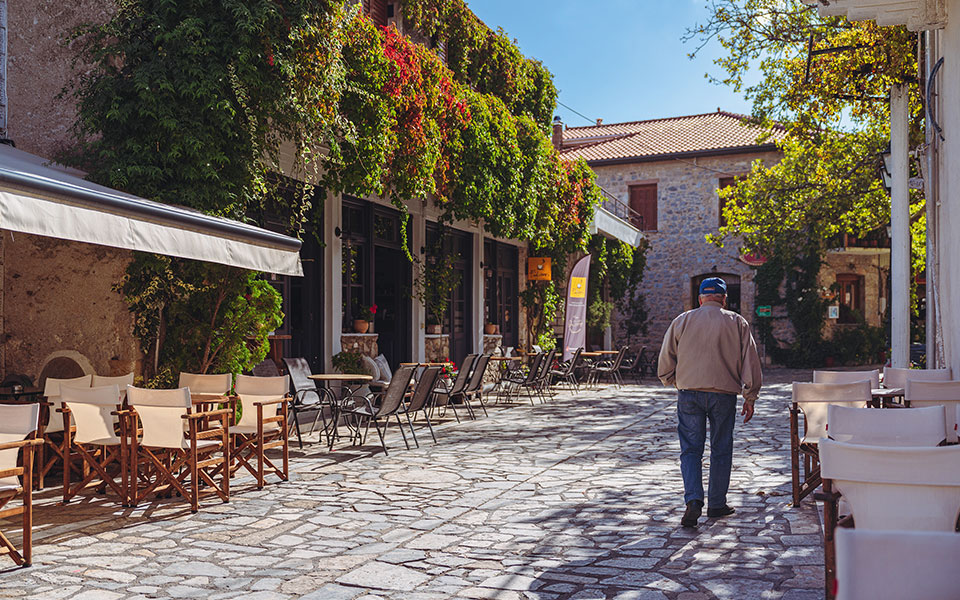
© Nicholas Masotras
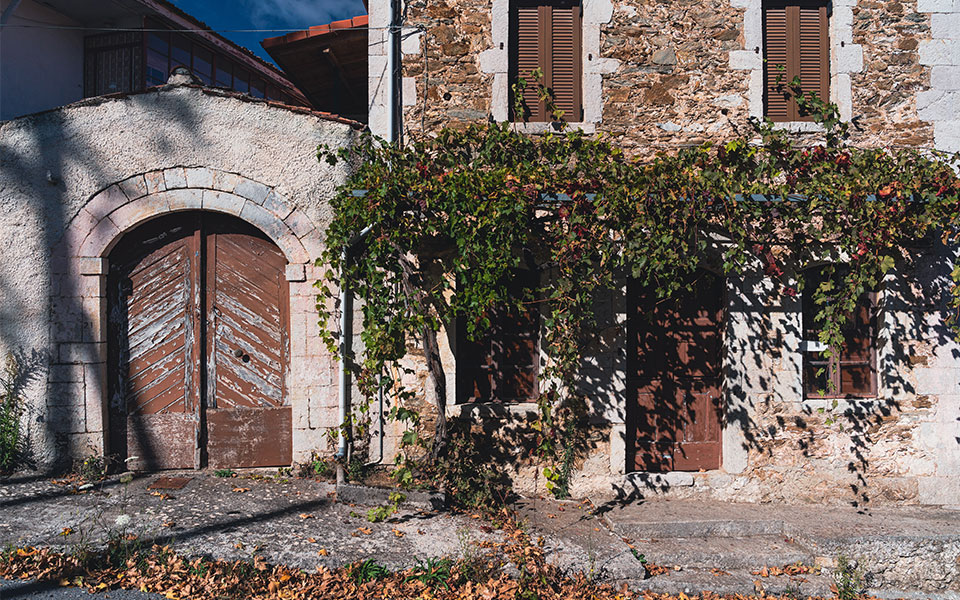
© Nicholas Masotras
Almost all the residents of Karyes, Laconia, own walnut and chestnut trees, most of them owning only a few hectares. The nuts they collect are enough to cover the needs of their own households, as well as those of their friends and acquaintances. Just like in other parts of Greece people grow olive trees to get the olive oil of the year, here everyone gets their own production of nuts. And this has been happening for thousands of years, as evidenced by the name of the village, for which the most likely explanation is that in the past, there also used to be many walnut trees in the area.
A few kilometers further north, in Vlahokerasia, in Arcadia, Christos takes care of his father’s estate with zeal and passion. In the past, there were more cherry trees here but as the years go by, the number of walnut and chestnut trees increases, as cherries bring less profit. Christos’ estate is located in the heart of the forest, surrounded by tall pine trees. His childhood memories are what motivates him to keep coming to the estate with his young son, Anastasis. New walnut and chestnut trees are planted, while the old ones offer their rich production every year.
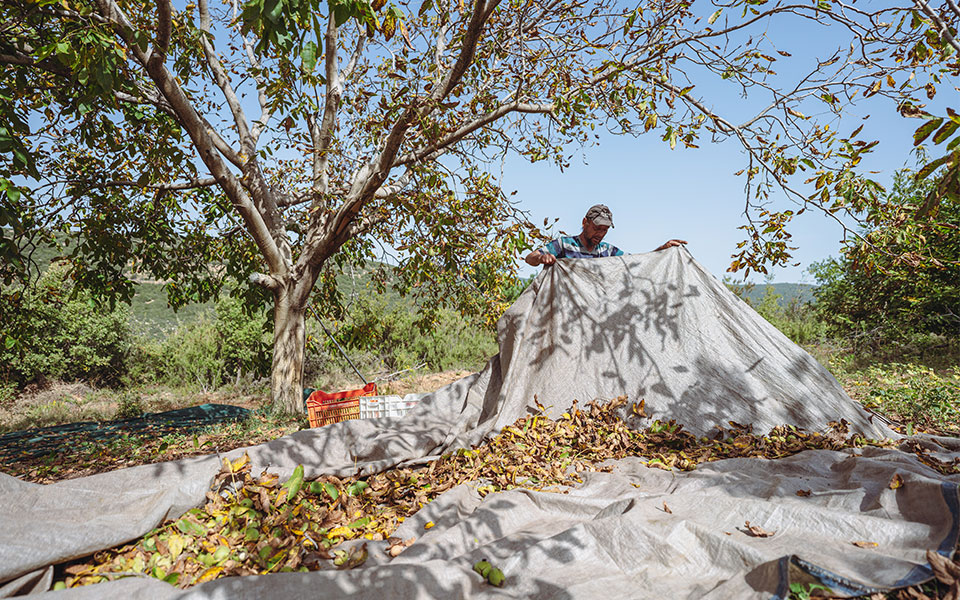
© Nicholas Masotras
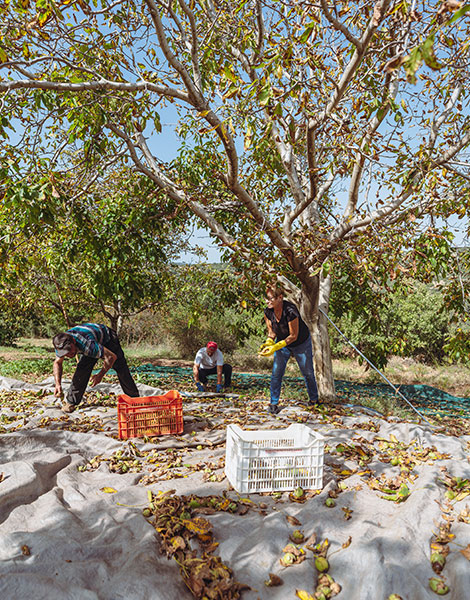
© Nicholas Masotras
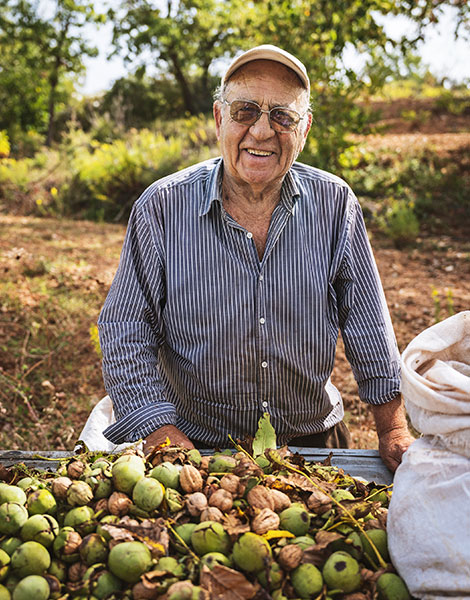
© Nicholas Masotras
Mountainous Place, Homeland of Expatriates
This area south of Tripoli, on the borders of Arcadia and Laconia, between the mountain masses of Parnonas and Taygetos, is scarred vertically by the old Tripoli-Sparta road, a 57-kilometer-long road axis, full of turns. Inns and resting places for travelers functioned along it in the past, while the last part of the historic Spartathlon Ultra Race passes through here. The inhabitants of the area are mainly engaged in agricultural work, while the high altitude dictates the cultivation of trees, such as cherries, chestnuts and walnuts.
In the past, many of the residents emigrated, setting up their lives from scratch in the United States and in Canada. This is evident both in Omogenon Square (meaning: the expatriates square), in Vlahokerasia, where you will find small signs indicating the distances in kilometers from that point to various places in the world where the expatriates emigrated, as well as in Karyes, where you will find inscriptions in various parts of the village with the donations and offers from expatriates.
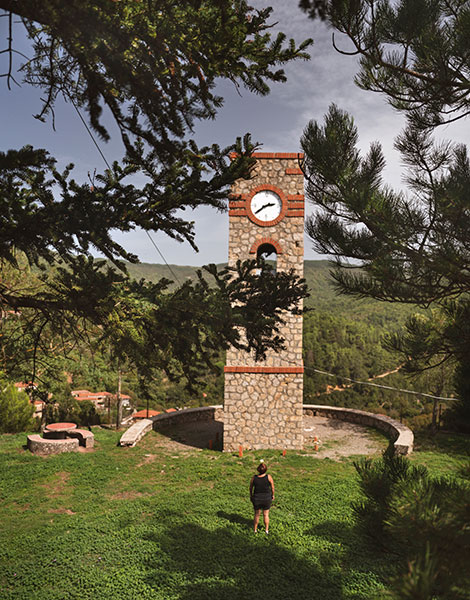
© Nicholas Masotras
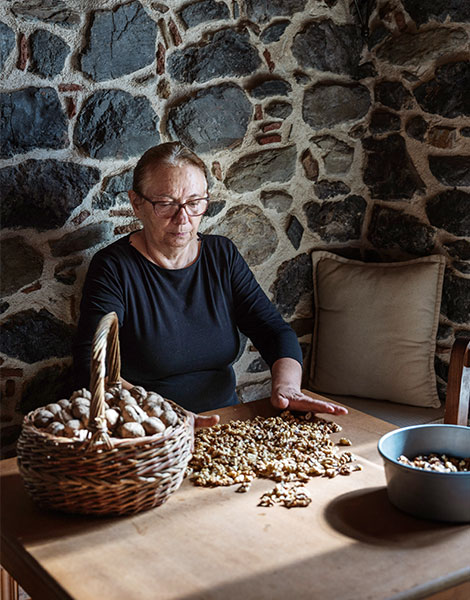
© Nicholas Masotras
Actions of Men
An invaluable contribution to the area is due to the forester Anastasios Stefanou, who comes from the village of Kerasia. On August 14, 1913, as described in his biography, he made a decision: “So one morning I grabbed a backpack and left the village. The surrounding area was bare, barren and desolate. In the Monastery of Kaltezia where I stopped to sleep, I made the decision to restore the old forest. I was 20 years old at the time. For 50 years this decision tormented my thoughts. Now the forest has become flamboyantly great. I fought hard for it. I put my soul into it.” After the establishment of the modern Greek state and until 1870, the old oak forest was cut down by the locals for its timber to such an extent that it was almost completely deforested. Stefanou made it his life’s goal to resurrect the old forest and, by enlisting clubs, organizations and residents, managed to start the reforestation in 1960.
Skiritida Forest is perhaps the only artificial forest in Greece covering an area of 5,200 hectares, 1,300 of which are private lands. The drive from Vlahokerasia to the village of Kollines reveals its beauty, with black pine, oak, chestnut and walnut trees dominating the landscape.
Walking is the best way to explore Skiritida Forest. The 14.5km long trail that crosses it is the product of the initiative and vision of an experienced mountaineer and hiker, Tasos Mitsios, who comes from this area. It took three years to open it, with minimal intervention, reviving old channels, creating steps and placing ropes in the few places where necessary. The trail that opened for use in 2010, attracts many nature-loving visitors and due to its proximity and easy access from Athens it has become one of the favorite choices of hiking groups and clubs.

© Nicholas Masotras
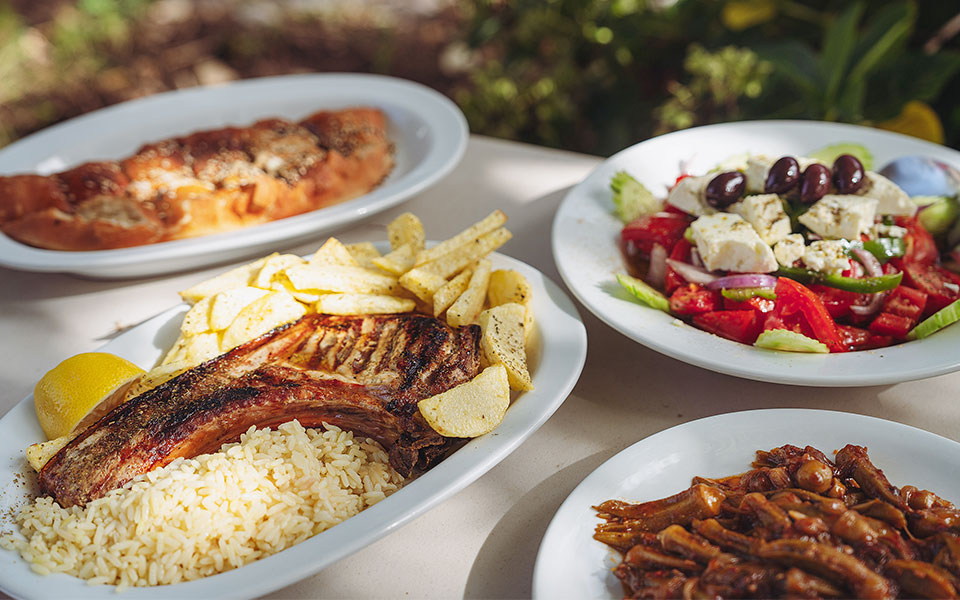
© Nicholas Masotras
A similar initiative has been demonstrated by the village of Karyes with resources from expatriates who have left bequests to the community. Thus, in the summer of 2020, seven hiking and four cycling trails around the village were completed. The Caryatides Trails Network passes through all points of interest both inside and outside the settlement. Legend has it that the “plane trees of Menelaus,” the four centuries-old plane trees that you will find on the way to the village of Aghios Petros, were originally planted by Menelaus (of Homeric fame) in 1100 BC.
In the same area, according to historical reports, was the sanctuary of Artemis Caryatis, where the priestesses of the temple danced religious dances. This is a tradition that is honored by today’s inhabitants of the village with the exact copy of the porch of the Erechtheion of the Acropolis, which depicts the Caryatids. It was built in 1983, in a prominent spot at the top of the village, from original Pentelic marble. As for the clock of Karyes, it stands in the place of the old one, which was destroyed on March 15, 1944, when the Germans looted, burned down and blew up all the houses in the village. The residents rebuilt them and the construction of the new clock was completed in 1955.
These little-known villages on the border between Arcadia and Laconia are rich in history, forests and autumn nuts and fruit. Tourism here has not brought large hotel units nor much infrastructure. It is an ideal place for visitors who seek nature in its unrefined and virgin version. The inhabitants will welcome them, still carrying wood from the mountain for their fireplaces and stoves and getting their hands stained black while removing the outer walnut shells, while in the forests, the first rains will fall and the drops will be the seeds of the next spring to come.
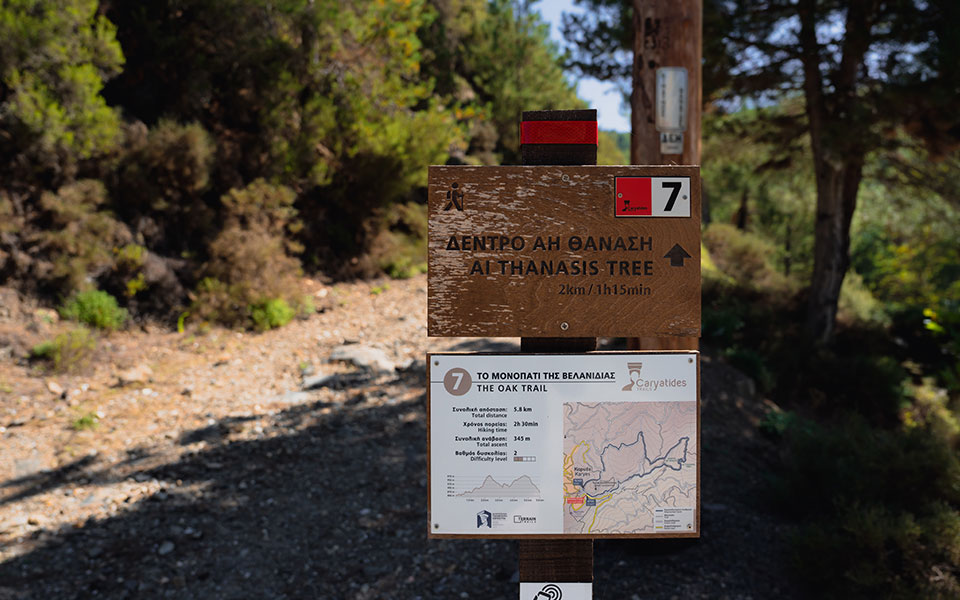
© Nicholas Masotras
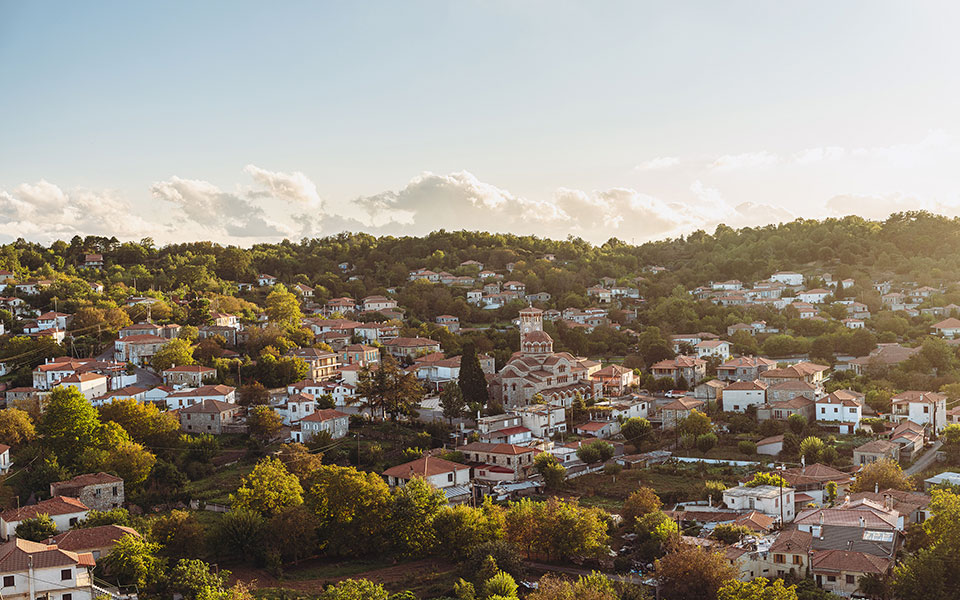
© Nicholas Mastoras
Walking the Trails
The Skiritida Forest Trail is a 14.5km long circular trail that starts and ends in the village of Vlahokerasia. The trail is clearly marked, it has small altitude differences and is also suitable for beginners. It takes about 5-6 hours depending on your pace. Note that about 80% of the route is under the shade of trees. The Caryatides Trails Network consists of seven trails covering approximately 56 kilometers in and around the village of Karyes. The first one is the Village Trail, which is 4.7km long and passes by all the sights of Karyes. The second is the 7.4km long Shepherd’s Trail that passes through hundreds of almond leaved pears (wild pears), meadows and fountains.
The Ancient Trail is 11.1km long and was carved over ancient roads that connected Karyes with other settlements, while the Water Trail is 4.4km long and passes by a reservoir that the locals call Limni (meaning: lake). The Forest Trail is 9.5km long, reaches an altitude of 1,250m and passes through boar habitats. The Chestnut Trail is a demanding route of 9.7km that passes between old estates, next to streams and of course chestnut trees, while the 5.8km long Oak Trail crosses the densest parts of the forest, where oaks dominate. Around Karyes, four cycling routes of 5, 9, 16 and 21km have been created and marked. You will find informative maps and descriptions of the trails in every shop pf the village but also online here.

